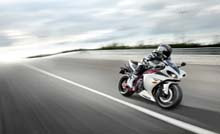 The VN1700 Classic Cruiser is one of three new models released this year to satisfy what Kawasaki sees as a gap in
The VN1700 Classic Cruiser is one of three new models released this year to satisfy what Kawasaki sees as a gap inthe marketplace. The Voyager is the mile muncher with its huge batwing fairing, triple headlights and integrated
panniers; with the Classic being bare and bold by comparison. I took the middle road and jumped on the Classic
Tourer for a day's ride out with a Road King rider to see how it steps up to the Harley-Davidson mark.
It's difficult not to compare a Japanese cruiser with the American alternative, they are after all, quite literally
the kings of the road when it comes to torquey twins splashed with gleaming chrome. But Kawasaki has done itself proud with this 'fully dressed' Classic in many respects. There's a fluidity to the design that flows from the head of the elegant 20-litre tank and its integrated instrument dials, to the luxury passenger backrest.
A singular, circular headlight protrudes from the base of the handlebar-mounted windscreen, which is both

adjustable and effective. The ridge of it falls just below my eye line and while it offers a perfectly acceptable
level of protection, slouching like a teenager with hormonal issues significantly reduced the little head buffeting I had.
I was instantly welcomed into a bubble of quiet calmness that almost made me envious of five footers ... almost.
The VN may be as balanced as a good accountant's cheque book but it's a still an imposing bulk and I was grateful
of my elongated limbs when hauling it off the side-stand. That said, the scooped seat is only 730mm high, so it's by no means off limits to shorter riders. By comparison to the Road King, the riding position feels plusher, as though you're sitting in the heart of the bike, cradled in the curves and chrome, as opposed to on top of it.
Although the styling is tidy and simple, there are finer details like the V-shaped rear light that's wedged between the rounded 38-litre panniers. It's the first time Kawasaki has used an LED taillight on a bike in this genre but that's just the tip of the iceberg.
 Beneath the classic retro design lies a wealth of technology that brings this low rider up to speed. Cruise control
Beneath the classic retro design lies a wealth of technology that brings this low rider up to speed. Cruise controlis almost a given on this kind of motorcycle, but where the Road King uses a mechanical system, the VN1700 works
electronically with the ECU and can hold any speed between 30 and 85mph in third gear or higher. It's cancelled
instantly with a dab of brake, clutch or by closing the throttle. Following behind the Road King, it was noticeably
more efficient as changes in the road's elevation did little to alter the Kwaka's speed. Unfortunately, that meant constantly applying the brakes uphill to avoid rear-ending the slowing Harley.
The power delivery from the 1700cc V-twin is smooth and precise thanks to Kawasaki's first fully electronic
throttle valve (ETV) system which is standard on all three bikes in this range. It analyses the movement from the conventional throttle cable and provides a crisp response by ensuring the butterfly openings, ignition timing and engine mapping are always spot on.

Heel-toeing through the six-speed gearbox is a relatively smooth affair, with the odd clunk accompanying clutchless
changes. And on the motorway, dipping below 70mph (which is after all the legal limit in the UK) the bike begins to
shudder as the revs drop too low. Knocking it back a gear softens the lumpiness like a wooden spoon on hardened butter and makes the power feel far more available.
100 ft lb of torque rests like a coiled spring at 2,750rpm and although there is a lively surge available
throughout the rev range, the bike weighs 378kg (kerb mass) so the punch isn't particularly explosive. It is,
however, more than enough for blasting overtakes and the endless chasing of bends. And subtle and effective engine braking is backed up with a more potent stopping power just a two-fingered squeeze away.
The VN1700 pours as easily through the twisties like runny honey from a warm spoon. It has genuinely sweet
handling. It feels neutral and compliant, and you don't have to be built like Arnie to enjoy throwing the bike on
its boards.
Kawasaki has disguised the bike's bulk as well as vertical stripes on a plus size model, so it is good fun, but it
will also deck out. It doesn't require that much lean angle to have the footboards scraping, but it is noticeably
less restricted than other oriental options like the XVS950A and it's comparable to Harley-Davidson's own Road King.
Need to know Kawasaki VN1700 Classic Tourer
Model: Kawasaki VN1700 Classic Tourer,
£10,799 (£10,999 Two Tone).
Engine: Transmission six-speed
Weight: 378kg
Seat height: 730mm
Fuel capacity: 20 litres
















